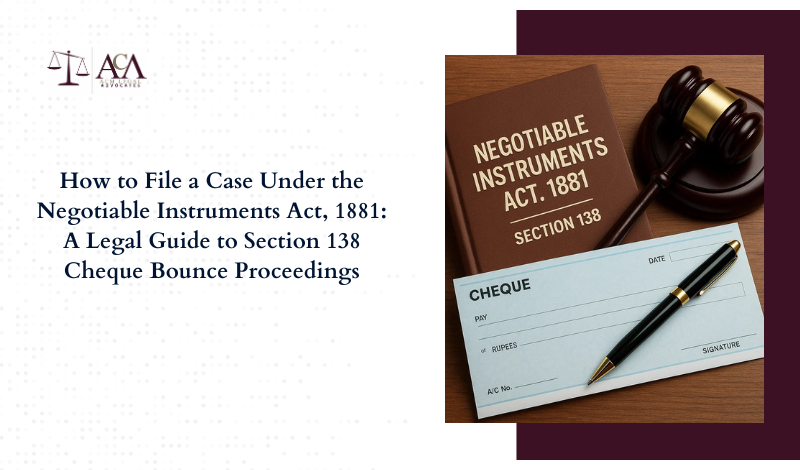Section 1:
Understanding Section 138 of the Negotiable Instruments Act, 1881
Section 138 of the Negotiable Instruments Act, 1881, serves as a pivotal legal provision in India, addressing the dishonour of cheques due to insufficient funds or other reasons. This section criminalizes the act of issuing a cheque that is subsequently dishonoured, provided certain conditions are met. The primary objective is to ensure the credibility of cheques as a reliable mode of payment and to instill financial discipline among individuals and entities.
Key Elements of Section 138:
- Issuance of Cheque: The drawer must have issued a cheque to discharge a legally enforceable debt or liability.
- Presentation of Cheque: The cheque should be presented to the bank within its validity period, typically three months from the date of issuance.
- Dishonour of Cheque: The cheque is returned unpaid by the bank due to reasons such as insufficient funds or exceeding the arrangement.
- Notice to Drawer: The payee must issue a written demand notice to the drawer within 30 days of receiving information from the bank regarding the dishonour of the cheque.
- Failure to Pay: The drawer fails to make the payment of the cheque amount within 15 days of receiving the demand notice.
Legal Implications:
Failure to comply with the above conditions can lead to the drawer being prosecuted under Section 138, which may result in:
- Imprisonment for a term that may extend to two years.
- A fine that may extend to twice the amount of the cheque.
- Or both, as deemed fit by the court.
Understanding these provisions is crucial for both the payee and the drawer to navigate the legal landscape effectively and to uphold the sanctity of financial transactions.
Section 2
Step-by-Step Procedure to File a Cheque Bounce Case Under Section 138 of the Negotiable Instruments Act
Filing a cheque bounce case under Section 138 of the Negotiable Instruments Act, 1881, requires strict adherence to legal formalities. The following procedural roadmap outlines how to file a case under the Negotiable Instruments Act and ensures effective legal recourse for dishonoured cheques:
Step 1: Dishonour of Cheque and Bank Return Memo
When a cheque is dishonoured, the drawee bank issues a cheque return memo specifying the reason, typically “insufficient funds” or “account closed.” This memo acts as primary evidence of dishonour and is vital to initiate legal action under cheque bounce laws in India.
Step 2: Service of Legal Demand Notice
Within 30 days of receiving the return memo, the payee must serve a legal notice for cheque bounce to the drawer. This demand notice must state that the cheque was issued to discharge a legally enforceable debt and has been returned unpaid. The notice must demand payment within 15 days, failing which legal action under Section 138 will be initiated.
Step 3: Expiry of 15-Day Grace Period
If the drawer fails to clear the cheque amount within the stipulated 15 days from receipt of notice, the cause of action arises. This is a mandatory waiting period before filing a cheque bounce case in court.
Step 4: Filing a Complaint Under Section 138
The complainant must file a complaint under Section 138 of the Negotiable Instruments Act within 30 days of the expiry of the grace period. The complaint should be filed before the Metropolitan Magistrate or Judicial Magistrate First Class, generally in the jurisdiction where the cheque was presented.
Step 5: Court Proceedings and Summons
After filing the case, the magistrate examines the complainant on oath under Section 200 of the Criminal Procedure Code. If a prima facie case is established, the court issues summons to the accused to appear and face trial for the dishonour of cheque under Section 138.
This procedure outlines the entire cheque bounce case filing process, ensuring compliance with all statutory timelines. Strict observance of these steps strengthens the complainant’s position and promotes swift justice under Indian banking laws.
Section 3
Jurisdiction and Court Procedure in Cheque Bounce Cases Under Section 138
The question of territorial jurisdiction in a cheque bounce case under Section 138 of the Negotiable Instruments Act was conclusively settled by the Supreme Court in Dashrath Rupsingh Rathod v. State of Maharashtra (2014) and subsequently clarified by the Negotiable Instruments (Amendment) Act, 2015. As per the amended provision, the complainant must file the case in the court within whose local jurisdiction the bank branch where the cheque was presented for encashment is situated.
Jurisdictional Rule Post-2015 Amendment:
- The place of filing a cheque bounce case is where the payee’s bank branch (i.e., where the cheque was deposited for collection) is located.
- If the cheque was handed over to a bank through an account, the relevant branch of that bank determines the territorial jurisdiction.
Procedure Followed by Court After Filing:
- Scrutiny of Complaint and Documents:
- The court reviews the written complaint, the original dishonoured cheque, the return memo, and a copy of the legal notice served to the drawer.
- The court reviews the written complaint, the original dishonoured cheque, the return memo, and a copy of the legal notice served to the drawer.
- Pre-summoning Verification:
- The magistrate records the statement of the complainant under oath under Section 200 CrPC.
- Supporting documents and affidavits are examined to establish prima facie offence under cheque dishonour law.
- The magistrate records the statement of the complainant under oath under Section 200 CrPC.
- Issuance of Summons:
- If satisfied, the magistrate issues summons to the accused under Section 204 CrPC.
- If the accused does not appear, bailable or non-bailable warrants may be issued.
- If satisfied, the magistrate issues summons to the accused under Section 204 CrPC.
- Plea and Trial:
- On appearance, the accused pleads guilty or not guilty.
- If not guilty, the case proceeds to trial, where the complainant and accused both lead evidence and are cross-examined.
- On appearance, the accused pleads guilty or not guilty.
- Final Arguments and Judgment:
- After evaluating the evidence and hearing final arguments, the magistrate passes judgment.
- If convicted, the accused may be punished with imprisonment up to two years, or fine up to double the cheque amount, or both.
- After evaluating the evidence and hearing final arguments, the magistrate passes judgment.
This framework ensures a consistent and effective redressal mechanism for dishonoured cheque cases, promoting accountability and financial discipline. The proper knowledge of jurisdiction in cheque bounce cases helps avoid unnecessary delays and dismissal on technical grounds.
Section 4
Essential Documents Required to File a Cheque Bounce Case Under Section 138
To effectively initiate a criminal complaint under Section 138 of the Negotiable Instruments Act, it is imperative to furnish all necessary documents that establish the legal debt, issuance of cheque, dishonour, and non-payment post notice. Courts insist on complete documentation to ensure the prima facie validity of the complaint and to expedite proceedings under cheque bounce law in India.
List of Mandatory Documents:
- Original Dishonoured Cheque: The physical copy of the cheque returned unpaid by the bank is primary evidence of the transaction.
- Bank Memo/Return Memo: Issued by the bank, this memo mentions the reason for dishonour (e.g., “Funds Insufficient,” “Account Closed”), which is central to filing a cheque bounce case.
- Copy of Legal Demand Notice: A copy of the statutory notice issued to the drawer within 30 days of dishonour demanding payment of the cheque amount.
- Proof of Service of Notice: Postal receipts, tracking reports (Speed Post/Acknowledgment), or affidavit of service evidencing that the notice was sent and delivered to the drawer.
- Complainant’s Affidavit and Verification Statement: A sworn affidavit confirming the facts of the case, including the debt, cheque issuance, dishonour, and non-payment.
- Statement of Account (Optional): Where necessary, a statement from the complainant’s bank showing no credit of the cheque amount into their account.
- Authorization Document (If Filing Through Power of Attorney or Representative): In case the complaint is filed by an authorized agent, an attested Power of Attorney or Board Resolution is required.
These documents are critical in establishing the existence of a legally enforceable debt and compliance with the statutory requirements of Section 138. Proper documentation not only strengthens the case but also reduces the chances of procedural objections by the defence.
Section 5
Defences Available to the Accused in a Cheque Bounce Case
While Section 138 of the Negotiable Instruments Act is stringent in ensuring the integrity of cheque-based transactions, the law also allows the accused to raise valid defences against allegations of cheque dishonour. These defences, if substantiated, can rebut the statutory presumption under Section 139 of the Act, which assumes that the cheque was issued for a legally enforceable debt or liability.
Common Legal Defences in Cheque Bounce Cases:
- Cheque Was Not Issued for a Legally Enforceable Debt: The accused can argue that the cheque was issued as a security, not towards a legally recoverable debt. If the complainant fails to prove the underlying debt or liability, the complaint may fail.
- Post-Dated or Blank Cheque Misused: The drawer may contend that the cheque was blank or post-dated and filled in without consent, which amounts to misuse.
- No Service of Legal Notice: If the accused can prove that the statutory legal notice was never received, or was sent to an incorrect address, the complaint may be rendered invalid.
- Cheque Presented After Expiry Period: A cheque presented after three months from the date of issuance becomes stale, and its dishonour does not give rise to an offence under Section 138.
- Payment Already Made: The accused may produce documentary evidence showing that the debt was already discharged before or within the 15-day statutory period post receipt of the notice.
- Forgery or Counterfeit Cheque: A forged cheque or a cheque issued under coercion or fraud may be grounds for dismissal of the complaint.
It is important to note that the burden of proving these defences lies on the accused. However, once a plausible defence is raised, the complainant must produce sufficient and credible evidence to sustain the charge. A proper understanding of valid defences in cheque dishonour cases plays a crucial role in ensuring that justice is not mechanically rendered without judicial scrutiny.
Section 6
Penalties, Compensation, and Recent Legal Developments in Cheque Bounce Cases
The legal consequences of cheque dishonour under Section 138 of the Negotiable Instruments Act are not limited to criminal prosecution. Courts have the authority to impose penalties that act both as a punishment for the offender and compensation for the complainant. The legislative intent is to ensure financial accountability and deter the misuse of negotiable instruments.
Statutory Penalty Provisions:
- Imprisonment: The accused may be sentenced to imprisonment for a term up to two years upon conviction under Section 138.
- Fine: Courts may impose a fine up to twice the amount of the dishonoured cheque. This is often awarded in favour of the complainant as compensation.
- Compensation Under Section 357 CrPC: In addition to the above, courts may also direct the accused to pay compensation under Section 357(3) of the Criminal Procedure Code, especially where the sentence does not include imprisonment.
Recent Developments and Judicial Trends:
Introduction of Compounding Mechanism: The Supreme Court has encouraged the compounding of cheque bounce cases to reduce pendency. Compounding permits amicable settlement between parties even at later stages of litigation.
Speedy Trial Mandate: As per Meters and Instruments (P) Ltd. v. Kanchan Mehta (2017), courts have been urged to adopt a summary trial mechanism for the speedy disposal of Section 138 complaints.
Jurisdiction Clarified: Post-2015 amendment to the Act, jurisdiction lies where the complainant’s bank is located, facilitating ease of filing and eliminating confusion over territorial authority.
Digital Evidence & e-Summons: Courts now increasingly accept digital service of notices and electronic records as valid evidence in cheque dishonour cases, especially post-COVID reforms.
In light of these developments, legal practitioners and aggrieved payees must ensure procedural compliance while also leveraging these modern procedural enhancements. A proactive and well-documented approach increases the likelihood of securing timely relief under India’s cheque dishonour law framework.
Conclusion
Filing a cheque bounce case under the Negotiable Instruments Act, 1881, is a robust legal remedy for recovering dishonoured payments in India. However, it demands meticulous compliance with statutory timelines, jurisdictional rules, and documentary requirements. The law, while strict on defaulters, also upholds the principles of natural justice by allowing valid legal defences and promoting settlement wherever feasible.
As cheque dishonour litigation continues to form a significant part of India’s commercial dispute landscape, timely enforcement, legal clarity, and judicial efficiency remain vital. Stakeholders must therefore approach such matters with professional legal guidance to navigate the complexities and ensure a fair outcome.






